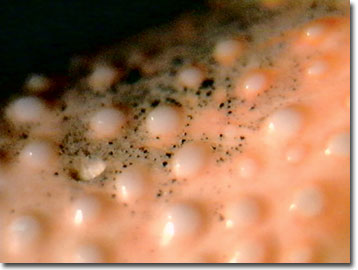Reflected Light Digital Image Gallery
Dungeness Crab (Cancer magister)
The Dungeness crab, Cancer magister, is a popular shellfish offered in fish markets and restaurants worldwide as a seafood delicacy. Named for a shallow, sandy bay they inhabit adjacent to the Dungeness Spit of the Straits of Juan de Fuca, these marine crustaceans are found along the Pacific Coast of North America from Cook Inlet near the North Pole, south to Magdalena Bay, Mexico.

View a second image of a Dungeness crab (Cancer magister).
Supporting both commercial and private anglers, Dungeness crabs have a broad, oval body covered by a hard, chitinous shell. With a pair of claws and four pairs of walking legs, Cancer magister differs from other commercially valuable crabs such as the king and Tanner crabs because they have much shorter and narrower legs and the top of their carapace is spineless.
Although Dungeness crabs prefer sandy or muddy substrates in the subtidal zone of the coastal waters, they have been found in deep waters to 180 meters in depth and can tolerate the lower salinities of estuaries. When not feeding on other crabs, clams, or marine worms, these crabs remain buried in the sand. Paralytic shellfish poisoning has been detected in the internal organs of Dungeness crabs, and consequently the organs, including the hepatopancreas (or "crab butter"), should be avoided when consuming these tasty marine malacostracans.
In the late spring, C. magister hard-shelled males mate with soft-shelled females. Until the fall, the female stores the sperm in a seminal receptacle before fertilization. The fertilized eggs are extruded in a mass known as the sponge, which remains attached to the female. Large females may bear more than 2.5 million eggs that develop over the winter and hatch in the early spring. The larval crabs hatch and swim freely, growing and molting several times before resembling small, demersal Dungeness crabs. It takes between two and three years for the crabs to reach a size that is sustainably harvestable. This is a year after the male reaches sexual maturity, and in most waters, the females are protected from taking.
Contributing Authors
Cynthia D. Kelly, Thomas J. Fellers and Michael W. Davidson - National High Magnetic Field Laboratory, 1800 East Paul Dirac Dr., The Florida State University, Tallahassee, Florida, 32310.
BACK TO THE REFLECTED LIGHT IMAGE GALLERY
BACK TO THE DIGITAL IMAGE GALLERIES
Questions or comments? Send us an email.
© 1995-2025 by Michael W. Davidson and The Florida State University. All Rights Reserved. No images, graphics, software, scripts, or applets may be reproduced or used in any manner without permission from the copyright holders. Use of this website means you agree to all of the Legal Terms and Conditions set forth by the owners.
This website is maintained by our
Graphics & Web Programming Team
in collaboration with Optical Microscopy at the
National High Magnetic Field Laboratory.
Last Modification Friday, Nov 13, 2015 at 01:19 PM
Access Count Since September 17, 2002: 11343
Visit the website of our partner in introductory microscopy education:
|
|
